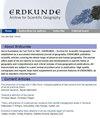How geoecological components of a terroir can be altered by spatial changes of vineyards – A case study from Eger Wine District (Hungary)
IF 1.1
4区 社会学
Q3 GEOGRAPHY
引用次数: 0
Abstract
Terroir is a concept referring interactions of natural (topography, lithology, climate, soil etc.) and human (economic conditions, traditions, cultivation practices, etc.) factors; therefore, terroir is spatially delimited and subjected to environmental, socio-economic, and temporal changes. The geoecological background of wine districts are considered more stable among them, but, because of its natural diversity and the spatial changes of production sites, changes in abiotic terroir components might occur too. In this study the spatial changes of grape production sites in Eger Wine District (Hungary) across two and a half centuries (1784 to 2018), and their consequences on the composition of the geoecological factors (lithology, topography, soil characteristics) were analyzed. Modernization of cultivation, urbanization and increase of built-up areas around the central settlement resulted in decreased concentration, i.e. increased spatial dispersion to more remote vineyards further from Eger. It also has consequences on the lithological and topographical composition of the production sites. Besides the slightly increasing extent of vineyards (from 5346 ha to 7413 ha) we found a distinct decrease of vineyards at higher elevations and a substantial increase at lower elevations. Distribution according to slope gradient changed also remarkably, with the share of vineyards on <5 % slopes from 38 % to 65 %. These changes resulted in transformations of pedological characteristics according to the comparison of vineyard’s extent with soil map data: vineyards shifted to slightly acidic, more fertile (i.e. deeper soil layer with higher organic carbon content) soils. The share of vineyards with different lithology and parent material also changed: loose, calcareous Tertiary sediments decreased almost to half, and the share of vineyards over acidic volcanics and their weathered regoliths almost doubled. Comparing these two dominant lithological types and soil profiles derived from them, different pedological characters and taxonomic status were found (Phaeozems and Vertisols). However, comparison of these two lithological types based on main topsoil characteristics (pH, SOC, carbonates, depth of fertile soil layer, N, P, K content) according to 25 randomly chosen surficial soil samples at production sites, showed no significant differences.. In the case of this particular wine district, spatial changes of the production sites affected mostly the distribution by elevation, by slope gradient, but did not alter significantly the surface soil character of the terroir.葡萄园的空间变化如何改变风土的地质生态成分——以匈牙利埃格尔葡萄酒区为例
风土是指自然因素(地形、岩性、气候、土壤等)和人类因素(经济条件、传统、耕作方式等)相互作用的概念;因此,风土在空间上是有界限的,并受到环境、社会经济和时间变化的影响。其中,葡萄酒产区的地质生态背景较为稳定,但由于产区的自然多样性和产地的空间变化,非生物风土成分也可能发生变化。本研究分析了匈牙利埃格尔葡萄酒产区两个半世纪(1784年至2018年)葡萄产地的空间变化及其对地质生态因子(岩性、地形、土壤特征)组成的影响。种植现代化、城市化和中心聚落周围建成区的增加导致集中度下降,即增加了向远离埃格尔的更偏远葡萄园的空间分散。它还对生产地点的岩性和地形组成产生影响。除了葡萄园面积略有增加(从5346公顷增加到7413公顷)外,我们发现高海拔地区的葡萄园面积明显减少,而低海拔地区的葡萄园面积则大幅增加。坡度分布也发生了显著变化,5%坡度上的葡萄园比例从38%上升到65%。这些变化导致了土壤学特征的转变,根据葡萄园范围与土壤地图数据的比较:葡萄园转向微酸性,更肥沃(即土层更深,有机碳含量更高)的土壤。具有不同岩性和母质的葡萄园的比例也发生了变化:松散的钙质第三纪沉积物几乎减少了一半,酸性火山及其风化风化层的葡萄园比例几乎翻了一番。对比这两种主要的岩性类型及其衍生的土壤剖面,发现不同的土壤学特征和分类地位(Phaeozems和Vertisols)。然而,根据生产地点随机选取的25个表层土壤样品的主要表层土壤特征(pH、有机碳、碳酸盐、肥沃土层深度、N、P、K含量)对这两种岩性类型进行比较,发现差异不显著。在这个特殊的葡萄酒产区,生产地点的空间变化主要影响了海拔和坡度的分布,但没有显著改变风土的表层土壤特征。
本文章由计算机程序翻译,如有差异,请以英文原文为准。
求助全文
约1分钟内获得全文
求助全文
来源期刊

Erdkunde
地学-自然地理
CiteScore
2.00
自引率
7.10%
发文量
17
审稿时长
>12 weeks
期刊介绍:
Since foundation by Carl Troll in 1947, ''ERDKUNDE – Archive for Scientific Geography'' has established as a successful international journal of geography. ERDKUNDE publishes scientific articles covering the whole range of physical and human geography. The journal offers state of the art reports on recent trends and developments in specific fields of geography and comprehensive and critical reviews of new geographical publications. All manuscripts are subject to a peer-review procedure prior to publication. High quality cartography and regular large sized supplements are prominent features of ERDKUNDE, as well as standard coloured figures.
 求助内容:
求助内容: 应助结果提醒方式:
应助结果提醒方式:


